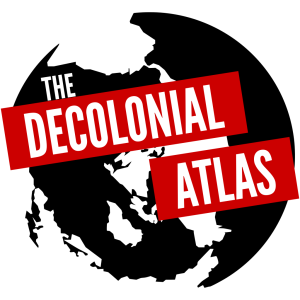For as long as anyone can remember, Irish culture has sustained the tradition of dinnseanchas – ancient lore about the origins of Ireland’s many traditional place-names. Gaeilge, the Irish language, is one of Europe’s oldest languages, and is rooted in the land in ways that many other European languages are not. And yet, for centuries, colonial forces have continually tried to uproot Irish culture and Irish language. In the year 1800, the Act of Union brought the administration of Éire under British control. In typical colonial fashion, the new rulers’ first act was to map the land – a process known as the Ordnance Survey in Éire. The Ordnance Survey created ‘standardized’ English names for the island’s many features – townlands, rivers, hills – weakening and erasing local place-name traditions such as dinnseanchas.
Since that time, English has continued to replace Gaeilge not just in maps, but in all facets of Irish life. Gaeilge maps have always existed, but are uncommon since the Ordnance Survey made English the official language of Irish geography. For those seeking to relearn traditions like dinnseanchas, and decolonize Éire, finding map resources can be difficult. To make it easier, we’ve compiled 17 maps of Éire labelled with Gaeilge place-names.
These maps vary in style and content – there are handmade maps and digital maps, old and new, bilingual English/Gaeilge and monolingual Gaeilge, and maps with and without the Republic of Ireland–Northern Ireland border.
If you know of any maps we could add to this list, leave us a comment below or email us at decolonialatlas@gmail.com
Map 1 – Léarscáil na hÉireann, 1948
Map 2 – Éire. Source: Fallon’s Irish School Atlas circa 1948.
Map 3 – Placenames in Irish. Source: Ball State University
Map 4 – 16th Century Provinces and Family Name Heraldic Map Of Ireland. Source: Print Shop Bunratty
Map 5 – Bilingual Ireland / Éire in English and Gaeilge. Source: Alasdairgunn
Map 6 – Bilingual Republic of Ireland / Poblacht na hÉireann in English and Gaeilge. Source: 123RF
Map 7 – Source: St. Cronan’s School textbook
Map 8 – Borderless, physical Éire map. Source: Jordan Engel, Decolonial Atlas
Map 9 – Éire. Source: Malconeous
Map 10 – Poblacht na hÉireann. Source: Wikipedia
Map 11 – Poblacht na hÉireann agus Tuaisceart Éireann. Source: 123RF
Map 12 – Gaelic Athletic Association (GAA) jerseys – Póstaeir & Léarscáileanna – Éire. Source: Gael Linn
Map 13 – Éire. Source: The Learning Store
Map 14A – The Celtic nations – Breizh (Brittany), Kernow (Cornwall), Éire (Ireland), Mannin (Isle of Man), Alba (Scotland), and Cymru (Wales), labelled in Brezhoneg (Breton), Kernowek (Cornish), Gaeilge (Irish), Gaelg (Manx), Gàidhlig (Scottish Gaelic), and Cymraeg (Welsh). Source: Bloke22
Map 14B – The Celtic Nations. Source: Geobreizh
Map 15A – Tír Cholm Cille – Gaelic placenames of Éire and Alba, printed by Collins Bartholomew, 2003, concept and editing Roy N. Pedersen, poster can be purchased at www.gaelicbooks.org . Source: Colm Cille
Map 15B – A portion of the Tír Cholm Cille map showing Ulaidh (Ulster) / Tuaisceart Éireann (Northern Ireland)
Map 16 – Éire Thuaidh / Ireland North : A Cultural Map of Irish Place-Names. Source: OSNI, 1998
Map 17: Ireland Bilingual Wall Map. Source: National Geographic.

Map 18: Source: u/WaterYouUp2




















The 1st map is class, with some clan/thuath names included and battles dated etc. Well done, Maith thu!
LikeLike
Hey! I’m the guy who did #9, it was a gift for my Irish-Canadian grandparents! Love seeing it here.
LikeLike
it’s really interesting that, despite your comment on the Ordnance Survey, the most detailed map here is map 16 produced by the Ordnance Survey
LikeLike
Reblogged this on Man in the World and commented:
Reposting a very interesting article with a compilation of maps of Ireland in Gaelic.
LikeLike
What a brilliant act of love and service this is. Thank you.
LikeLike
Excellent work
LikeLike
I doubt it
LikeLike
Could you tell me, now, if England introduced alcohol to the Irish, as a means of wrecking that society?
LikeLike
How is Irish society “wrecked” except by British imperialism?
LikeLike
“British Imperialism” had a grand time with “The Opium Wars” against China, I’m just being ironic that England may have done to Ireland what they did to China – imagine “free British Beer” to get the party started. I’m an “ancestral” Irishman (father Canadian Irish) and my father a survivor of a father being a “A Drunken Irishman” an archetype that is still quite prevalent, an Irish bloke I know cannot give up getting blotto and fighting, because that’s his “Irish Heritage”.
LikeLiked by 1 person
They wrecked Irish society with the Irish famine. It was a genocide where millions died.
LikeLike